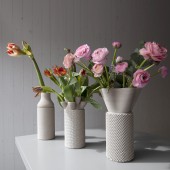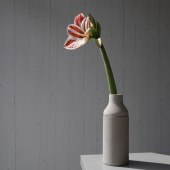Flwr Shpr (Flower Shaper) Vase by Dave Coomans & Gaudi Hoedaya |
Home > Winners > #48522 |
 |
|
||||
| DESIGN DETAILS | |||||
| DESIGN NAME: Flwr Shpr (Flower Shaper) PRIMARY FUNCTION: Vase INSPIRATION: We love ceramics, we love clay and its simplicity which in essence is earth. We love working with clay because we can use it over and over again. Break it, add water and we are good to go. By giving shape and firing it, it became purposeful and sustainable. We also love technology. So why not experiment with 3d printing clay? Creating shapes and textures that are difficult or even not doable using traditional methods. UNIQUE PROPERTIES / PROJECT DESCRIPTION: xprmnt (read: experiment) is our startup. We are building a 3D clay printer and one of the objects we designed to demonstrate its capability are these serie of vases. Our current 3D-printer is limited in its height so we came up with the idea to use extensions to reach usable heights. We gave each extensions a specific form so it help shape the flower-arrangement. Each base has its own texture from the basic yarn-look to the more complicated knitted-look to distinct from traditional hand shaped vases. OPERATION / FLOW / INTERACTION: For each flower or flower-arrangements, the user can choose from 3 vase base and 3 extensions so the most appealing or desired result can be achieved. PROJECT DURATION AND LOCATION: We began to build the 3D-printer a year ago. Mid 2015 - early 2016 we started to create signature designs which lead to these serie of vases. All designs are designed and made in Rotterdam, The Netherlands. |
PRODUCTION / REALIZATION TECHNOLOGY: Used machine: For our machine we can use clay directly from the packaging. To do that we built an extruder using waterjet and 3D-printed parts. The stepper-motor pushes the clay though a nozzle that can be attached to any 3D-printer. The self-built heated nozzle warms the clay up till 70 degrees so when it is out of the nozzle the clay dries up faster so more dramatic angles can be achieved. Otherwise the clay would collapse under its own weight. SPECIFICATIONS / TECHNICAL PROPERTIES: Vase base diameter: 10 cm, height: 18 cm Vase extensions or shaper diameter: vary from 10 cm to 18 cm, height: 15 cm TAGS: clay, ceramics, 3D-print, vase RESEARCH ABSTRACT: The challenge to print with clay is the material itself. It is sturdy so while others use water-diluted clay, we can use clay from the packaging directly. We built the machine ourselves using water-jet and 3D-printed parts. Our 3D-printer is limited in its height so when we decide to print a vase we came up with the idea to use extensions to reach usable heights. We gave each extensions a specific form so it help shape the flower-arrangement. CHALLENGE: Our research is experimenting with technology, material, textures and shapes. The chosen material, technique and design has to be in sync in order to create refreshing designs. The idea of having interchangeable bases and tops was generated by a limitation which we transforms into strength. The use of heated nozzle was driven by the material which otherwise will collapse by its own weight. We create textures that are difficult or even not doable using traditional methods. The design is the results of all the decisions above, plus a bit of magic. The PDF shows a visual explanation of our process. ADDED DATE: 2016-04-07 15:48:52 TEAM MEMBERS (4) : Design and Machine building: Dave Coomans, Design and Creative direction: Gaudi Hoedaya , Business development: Anne-Marie Godinho Nunes and Art direction and styling: Ursula Wurzinger IMAGE CREDITS: Photography: Ursula Wurzinger and Gaudi Hoedaya PATENTS/COPYRIGHTS: Copyrights belong to Dave Coomans and Gaudi Hoedaya, 2016 |
||||
| Visit the following page to learn more: http://www.xprmnt.nl | |||||
| AWARD DETAILS | |
 |
Flwr Shpr (flower Shaper) Vase by Dave Coomans & Gaudi Hoedaya is Winner in 3D Printed Forms and Products Design Category, 2015 - 2016.· Press Members: Login or Register to request an exclusive interview with Dave Coomans & Gaudi Hoedaya. · Click here to register inorder to view the profile and other works by Dave Coomans & Gaudi Hoedaya. |
| SOCIAL |
| + Add to Likes / Favorites | Send to My Email | Comment | Testimonials | View Press-Release | Press Kit | Translations |







